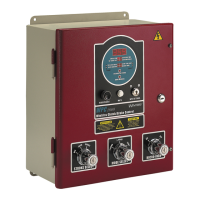Glossary G-1
Glossary
Cross-references to other glossary entries are shown in italics.
ACTS See Auto-compensated Top Stop.
ANSI Stands for American National Standards Institute, a U.S.
clearinghouse and coordinating body for voluntary standards
activity on the national level.
Auto Carry-up A signal that causes the press to automatically complete the
stroke, stopping at TDC, when the operator releases his hands
from the palm buttons after the Auto Carry-up Angle has been
reached. Also called “Operator Station mute.”
Auto Carry-up Angle The crank angle at which the pinch point has closed to less
than ¼ in. (6 mm), an opening determined by OSHA to be too
small to pose a hazard to the operator.
Auto-compensated Top
Stop (ACTS)
A WPC 1000 feature, designed specifically for variable-speed
presses, that adjusts the top-stop angle automatically as press
speed changes or the brake wears.
BDC Abbreviation for bottom dead center.
brake monitor A WPC 1000 feature that checks for brake wear.
calculated safety distance See safety distance.
cam channels Relays that open and close on signals from the programmable
cam switch to turn auxiliary equipment on and off at specified
crankshaft angles.
concurrent time The length of time within which each pair of palm switches on
all Operator Stations connected to WPC 1000 must be pressed
in order to start the press. This interval is 5 seconds. If the
concurrent time is exceeded by any Operator Station, the press
will not start.
control component failure Another name for control reliability.
control reliability A regulation defined in ANSI B11.1-1988 and OSHA
1910.217 requiring that a single component failure in a clutch/
brake control circuit not prevent the normal stopping action of
the press, not create an unintended stroke, and not allow
initiation of a subsequent stroke until the failure has been
corrected.
crank angle clock A ring of LEDs on the WPC 1000 optional display that shows
the angle of rotation of the press’s crankshaft.

